Sheetz Bundle
How Did Sheetz Revolutionize the Convenience Store Experience?
From a small dairy store to a regional giant, the Sheetz SWOT Analysis reveals a fascinating story of innovation. Founded in 1952 by Bob Sheetz, the company's journey showcases a remarkable transformation within the convenience store landscape. This evolution highlights how Sheetz strategically adapted to changing consumer needs, setting the stage for its impressive growth and market presence.
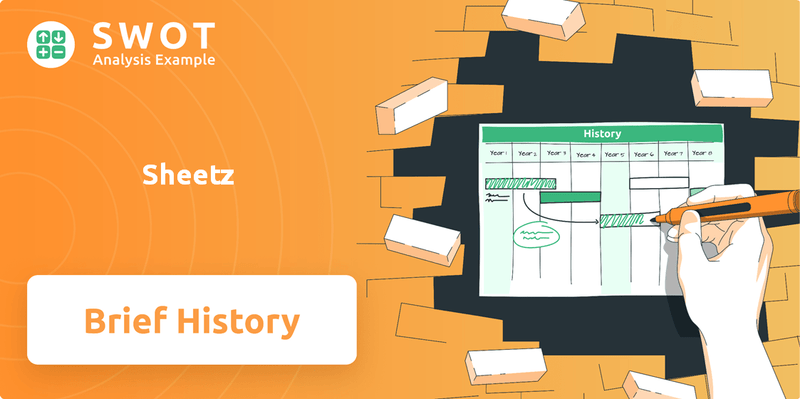
This brief history of Sheetz explores the Sheetz company origin, tracing its expansion from a single store to over 700 Sheetz stores across six states. The company's early adoption of made-to-order food and its focus on customer service have been key Sheetz milestones. Learn about Sheetz's impact on local communities and how it competes in today's market.
What is the Sheetz Founding Story?
The story of the Sheetz company begins on November 1, 1952, when Bob Sheetz opened a small dairy store in Altoona, Pennsylvania. This marked the genesis of what would become a significant player in the convenience store industry. Bob Sheetz's vision extended beyond simply selling dairy products; he aimed to provide a comprehensive and convenient shopping experience for the local community.
The original business model of the Sheetz company centered on offering milk, bread, and other essential groceries. The name 'Sheetz' was a direct reflection of the founder's family name, signifying a personal commitment to quality from the outset. The first store was primarily funded through Bob Sheetz's personal savings and hard work, laying the foundation for future growth.
One of the initial challenges for Sheetz was competing with established grocery stores and smaller local shops. However, the company differentiated itself by offering extended hours and a broader product selection, catering to the changing needs of consumers in post-war America. This period saw an increase in mobility and a demand for quick, accessible retail options, a trend that Sheetz was well-positioned to capitalize on.
The founding of Sheetz marked the beginning of a journey that would transform the convenience store landscape. From its humble beginnings as a dairy store, Sheetz quickly evolved, adapting to meet the demands of a changing consumer base. The early focus on convenience and a wide range of products set the stage for future expansion and innovation.
- Founded on November 1, 1952, in Altoona, Pennsylvania.
- Initial focus on dairy products and essential groceries.
- Named after founder Bob Sheetz.
- Differentiated itself through extended hours and product variety.
Sheetz SWOT Analysis
- Complete SWOT Breakdown
- Fully Customizable
- Editable in Excel & Word
- Professional Formatting
- Investor-Ready Format
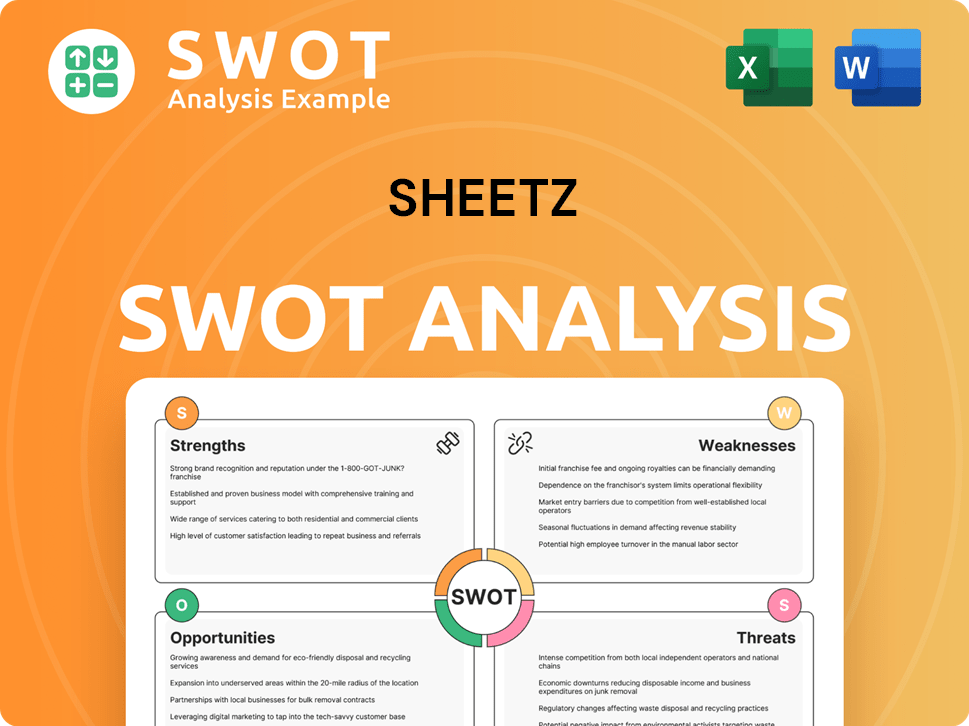
What Drove the Early Growth of Sheetz?
The early growth of the Sheetz company was marked by strategic expansion, evolving from its initial dairy store concept. This phase involved increasing product offerings and gradually increasing the number of Sheetz stores. Key decisions, such as incorporating gasoline sales, significantly boosted both customer traffic and revenue, establishing the hybrid convenience store and gas station model.
In 1961, Steve Sheetz joined the company, aiding in the expansion beyond its initial dairy store format. The pivotal move to include gasoline sales in 1972 transformed the business model, drawing in more customers. By 1973, the company had expanded to 14 locations, showing a steady growth trajectory. This expansion was a key part of the Sheetz company origin.
A significant innovation was the introduction of the 'Made-To-Order' (MTO) food concept in 1986, allowing for customized orders. This innovation catered to customer demand for fresher, personalized food options. Early customer acquisition strategies focused on convenience and a broader product selection. This focus on customer service helped the Sheetz company compete.
Geographic expansion beyond Pennsylvania into neighboring states was another key element of growth. This organic growth was primarily funded through reinvested profits. Stan Sheetz took over as president and CEO in 1995, carrying on the family's entrepreneurial legacy. By the late 1990s, Sheetz solidified its position as a regional leader, outperforming competitors. See more about the Owners & Shareholders of Sheetz.
The company's focus on fresh food and customer service was a key factor in its success. The Sheetz business model evolved to meet changing consumer needs. The expansion over time included adapting to market demands for fresh, customizable food options. The Sheetz stores became a significant presence in the convenience store industry.
Sheetz PESTLE Analysis
- Covers All 6 PESTLE Categories
- No Research Needed – Save Hours of Work
- Built by Experts, Trusted by Consultants
- Instant Download, Ready to Use
- 100% Editable, Fully Customizable
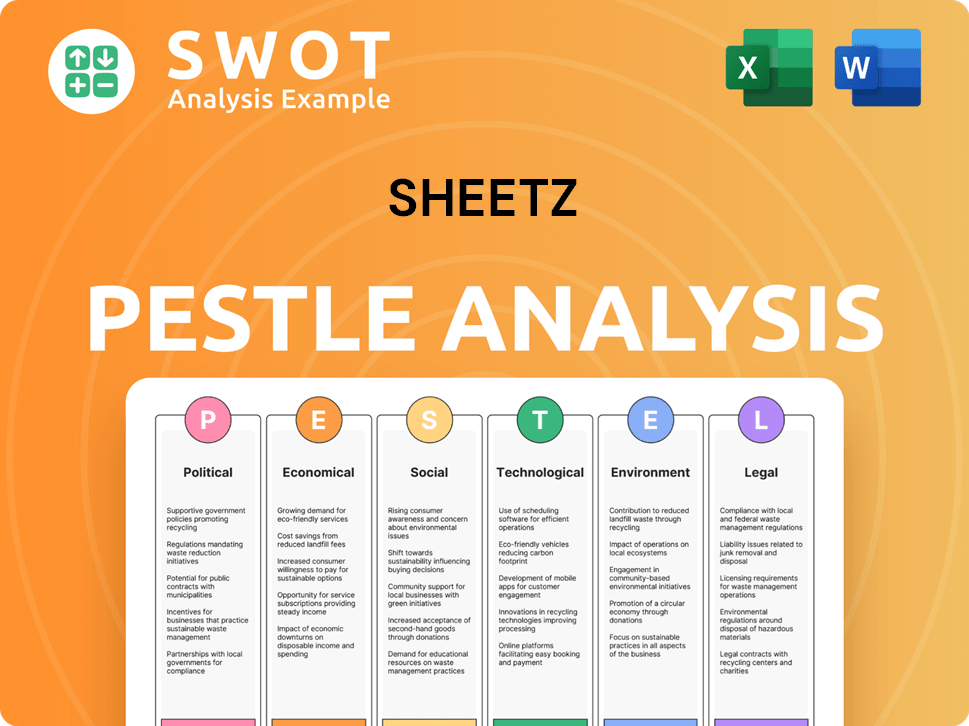
What are the key Milestones in Sheetz history?
The Sheetz company has achieved several milestones, significantly impacting the convenience store landscape. From its humble beginnings, Sheetz has grown into a major player in the industry, continuously adapting and innovating to meet the evolving needs of its customers. This growth reflects its commitment to excellence and customer satisfaction.
| Year | Milestone |
|---|---|
| 1952 | The first Sheetz store was established by Bob Sheetz in Altoona, Pennsylvania. |
| 1960s | Sheetz expanded its operations, opening additional Sheetz stores across Pennsylvania. |
| 1990s | Sheetz began to focus on food service, introducing made-to-order items and expanding its menu. |
| 1997 | Sheetz introduced touch-screen ordering, revolutionizing the customer experience. |
| 2004 | Sheetz launched Sheetz Bros. Coffeez, further diversifying its offerings. |
| 2024 | Sheetz continues to expand its footprint, with over 700 Sheetz locations across six states. |
Sheetz has consistently embraced innovation to enhance its customer experience and operational efficiency. A pivotal move was the introduction of touch-screen ordering, which streamlined the ordering process and reduced wait times. This technological advancement, along with the launch of custom coffee beverages, demonstrates Sheetz's dedication to staying ahead in the competitive market.
Introduced in 1997, this innovation revolutionized the customer experience by allowing for efficient and customized food orders. This technology significantly reduced wait times and improved order accuracy.
Sheetz expanded its food menu to include made-to-order items, providing customers with fresh and customizable options. This move enhanced the company's appeal and diversified its revenue streams.
Launched in 2004, this line of custom-made coffee beverages allowed Sheetz to compete with established coffee chains. This diversification strengthened its position in the market.
Sheetz has invested in mobile ordering and rewards programs to enhance customer convenience and loyalty. These digital initiatives improve customer engagement and drive repeat business.
Sheetz has adapted to changing consumer needs by offering various fuel options, including gasoline and electric vehicle (EV) charging stations. This diversification caters to a broader customer base.
Sheetz has focused on efficient supply chain management to ensure the freshness and availability of its food products. This focus on logistics supports its commitment to quality.
Despite its successes, Sheetz has faced challenges, including intense competition within the convenience store and fast-food sectors. Economic downturns have also impacted consumer spending, requiring the company to adapt its strategies. Maintaining consistent service quality across its expanding footprint and managing supply chain logistics for its fresh food program have also presented difficulties.
The convenience store and fast-food industries are highly competitive, requiring Sheetz to continuously innovate and differentiate itself. This includes competing with major players and local businesses.
Economic fluctuations can impact consumer spending on fuel and discretionary items, requiring Sheetz to adjust its strategies to maintain profitability. This includes focusing on its food service offerings.
Maintaining consistent service quality across a growing number of Sheetz locations is a significant operational challenge. This requires robust training and management practices.
Managing the supply chain for fresh food products across a large number of locations is complex. This includes ensuring timely delivery and maintaining product quality.
Adapting to evolving consumer tastes and preferences, including health-conscious options and diverse menu choices, is crucial for Sheetz to remain relevant. This requires continuous market research and menu innovation.
Managing labor costs and ensuring adequate staffing levels are ongoing challenges. This includes providing competitive wages and benefits to attract and retain employees.
Sheetz Business Model Canvas
- Complete 9-Block Business Model Canvas
- Effortlessly Communicate Your Business Strategy
- Investor-Ready BMC Format
- 100% Editable and Customizable
- Clear and Structured Layout
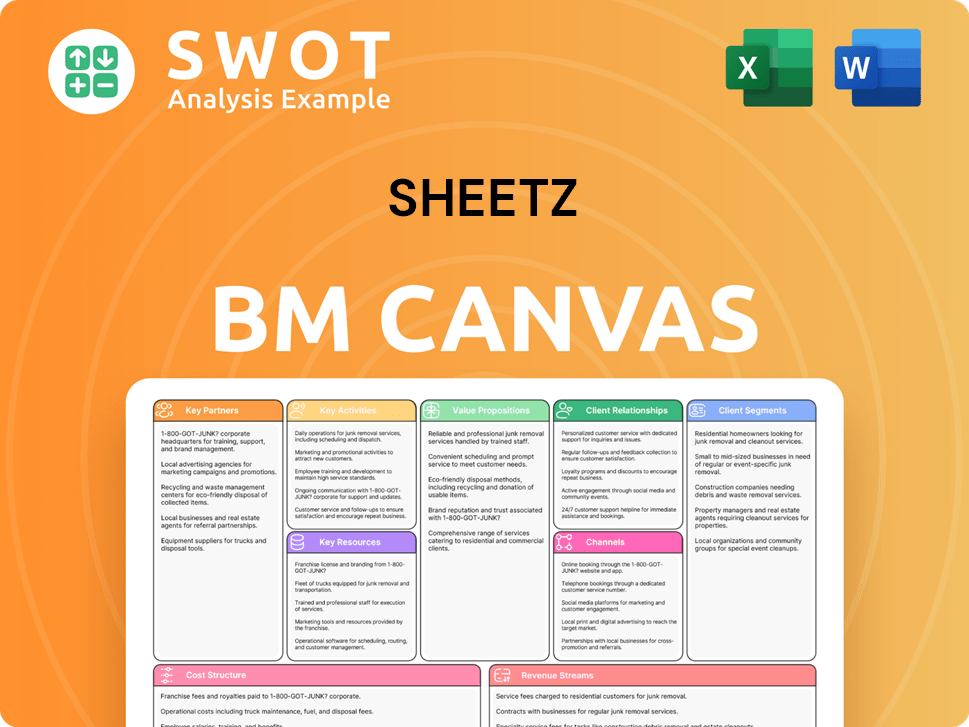
What is the Timeline of Key Events for Sheetz?
The Marketing Strategy of Sheetz has evolved significantly since its inception. The company, a prominent player in the convenience store industry, has a rich history marked by strategic expansions and innovative offerings. Beginning as a dairy store, it transformed into a convenience store and gas station, constantly adapting to meet customer needs and preferences. This dedication to innovation has propelled it to become a leading brand in the convenience retail sector.
| Year | Key Event |
|---|---|
| 1952 | Bob Sheetz opened the first Sheetz dairy store in Altoona, Pennsylvania, marking the company's beginning. |
| 1961 | Steve Sheetz joined the company, initiating a period of expansion and growth. |
| 1972 | Sheetz began selling gasoline, evolving into a convenience store and gas station model. |
| 1973 | The company expanded to 14 store locations. |
| 1986 | Sheetz introduced its 'Made-To-Order' (MTO) food concept, revolutionizing its food service. |
| 1995 | Stan Sheetz became President and CEO, guiding the company through further developments. |
| 1997 | Touch-screen ordering was implemented for MTO food, enhancing customer convenience. |
| 2004 | The Sheetz Bros. Coffeez line was launched, expanding its beverage offerings. |
| 2019 | Travis Sheetz became President and CEO, continuing the family leadership. |
| 2023 | Sheetz operated over 680 Sheetz stores and employed more than 24,500 people, demonstrating significant growth. |
| 2024 | Sheetz announced plans for further expansion, including its first store in Michigan. |
Sheetz plans to open approximately 30 new Sheetz stores in 2024. This includes its first location in Michigan, marking a significant move into new geographical markets. This expansion is a testament to the company's growth strategy and market penetration. The company aims to operate 1,000 stores by 2030.
The company is investing in technology to enhance its mobile ordering capabilities and loyalty programs. These advancements aim to personalize the customer experience and streamline operations. These efforts are crucial for maintaining a competitive edge in the fast-paced convenience retail industry, ensuring customer loyalty.
Sheetz is exploring new product categories and partnerships to diversify its offerings. This may include more health-conscious options and sustainable fuel alternatives. Such diversification aligns with evolving consumer preferences and environmental concerns. This strategy is crucial for long-term sustainability.
Sheetz's long-term strategic initiatives prioritize speed, quality, and customer satisfaction. These priorities echo the founding vision of providing ultimate convenience to its customers. By focusing on these key areas, Sheetz aims to maintain its leadership in the convenience retail sector.
Sheetz Porter's Five Forces Analysis
- Covers All 5 Competitive Forces in Detail
- Structured for Consultants, Students, and Founders
- 100% Editable in Microsoft Word & Excel
- Instant Digital Download – Use Immediately
- Compatible with Mac & PC – Fully Unlocked
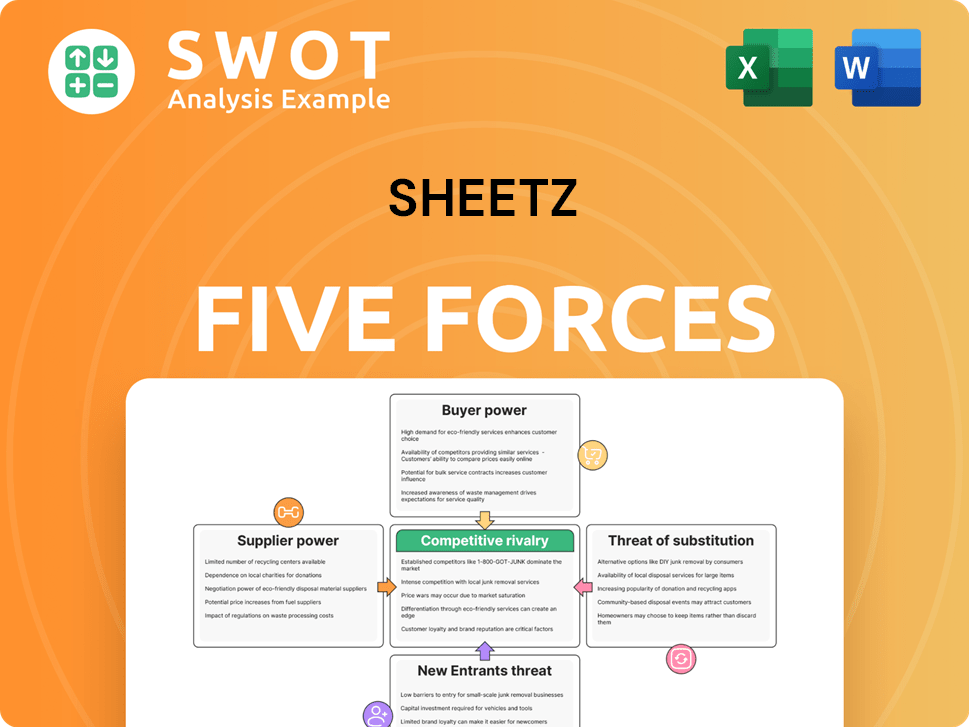
Related Blogs
- What is Competitive Landscape of Sheetz Company?
- What is Growth Strategy and Future Prospects of Sheetz Company?
- How Does Sheetz Company Work?
- What is Sales and Marketing Strategy of Sheetz Company?
- What is Brief History of Sheetz Company?
- Who Owns Sheetz Company?
- What is Customer Demographics and Target Market of Sheetz Company?
Disclaimer
All information, articles, and product details provided on this website are for general informational and educational purposes only. We do not claim any ownership over, nor do we intend to infringe upon, any trademarks, copyrights, logos, brand names, or other intellectual property mentioned or depicted on this site. Such intellectual property remains the property of its respective owners, and any references here are made solely for identification or informational purposes, without implying any affiliation, endorsement, or partnership.
We make no representations or warranties, express or implied, regarding the accuracy, completeness, or suitability of any content or products presented. Nothing on this website should be construed as legal, tax, investment, financial, medical, or other professional advice. In addition, no part of this site—including articles or product references—constitutes a solicitation, recommendation, endorsement, advertisement, or offer to buy or sell any securities, franchises, or other financial instruments, particularly in jurisdictions where such activity would be unlawful.
All content is of a general nature and may not address the specific circumstances of any individual or entity. It is not a substitute for professional advice or services. Any actions you take based on the information provided here are strictly at your own risk. You accept full responsibility for any decisions or outcomes arising from your use of this website and agree to release us from any liability in connection with your use of, or reliance upon, the content or products found herein.